Person-Centered Interview Questions: Clinical Reasoning and Assessment
VerifiedAdded on 2023/01/16
|11
|3047
|90
Report
AI Summary
This report focuses on person-centered interview questions within a nursing context, specifically addressing the case of a patient named Violet Kwong. The assignment begins with a summary of the patient's background, including her health history and current emotional state following the loss of her husband and her recent melanoma diagnosis. The core of the report involves the creation of five open-ended, person-centered interview questions designed to gather information about Violet's health history, living situation, mobility, diet, and overall needs. Each question is carefully crafted to foster trust and empathy, ensuring the patient feels respected and included in her own care. The report explains how each question aligns with person-centered care principles, emphasizing the importance of patient involvement, compassion, and understanding. The report concludes by summarizing how the collected information, including the patient's vital signs (RR, BP, HR, T), can be used to develop a comprehensive care plan, addressing both her physical and emotional well-being. The author highlights the significance of considering various factors like melanoma risk, mobility issues, nutritional needs, and psychological support to enhance the patient's quality of life. The report provides a detailed analysis of how these person-centered questions can improve patient outcomes and overall nursing care.
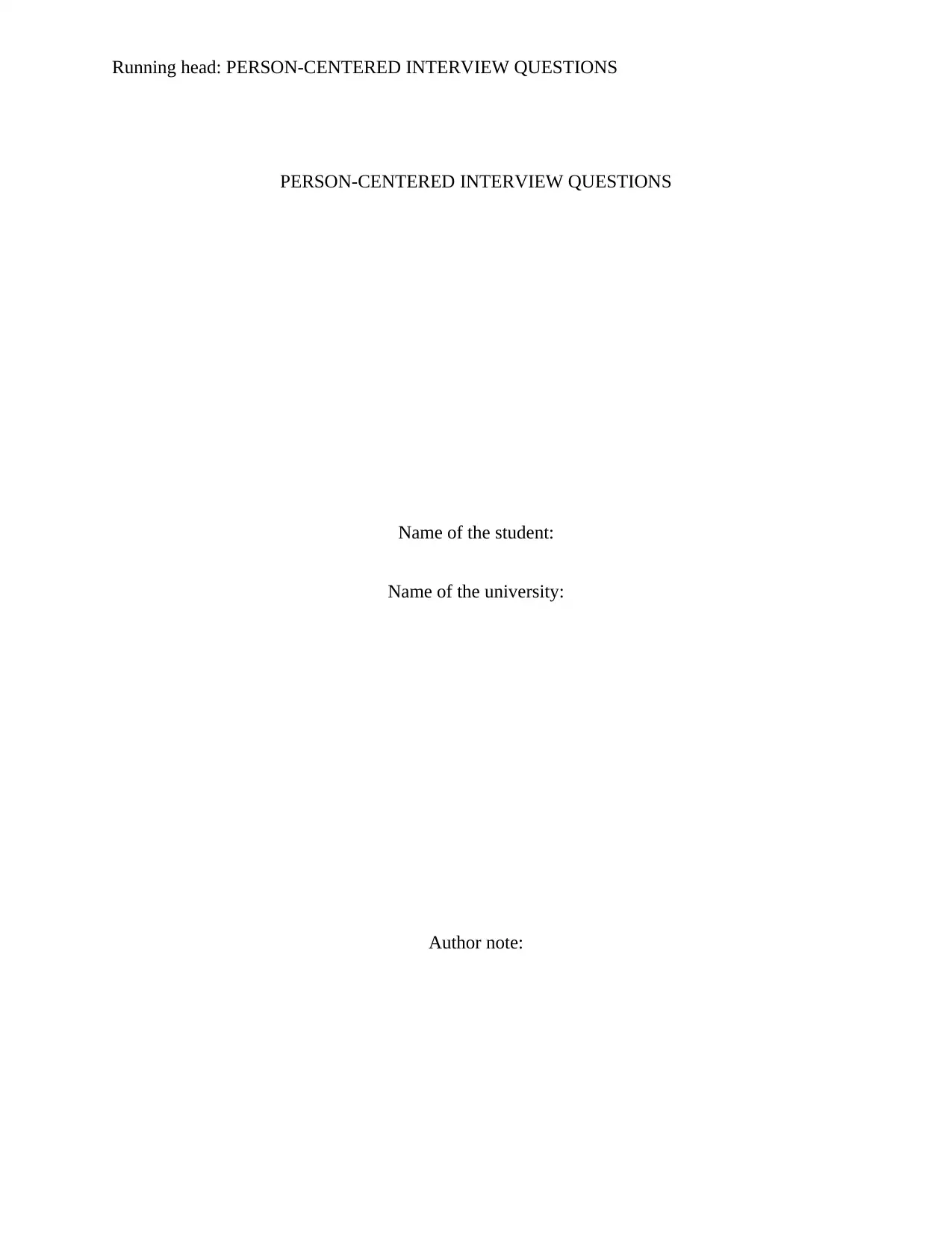
Running head: PERSON-CENTERED INTERVIEW QUESTIONS
PERSON-CENTERED INTERVIEW QUESTIONS
Name of the student:
Name of the university:
Author note:
PERSON-CENTERED INTERVIEW QUESTIONS
Name of the student:
Name of the university:
Author note:
Paraphrase This Document
Need a fresh take? Get an instant paraphrase of this document with our AI Paraphraser
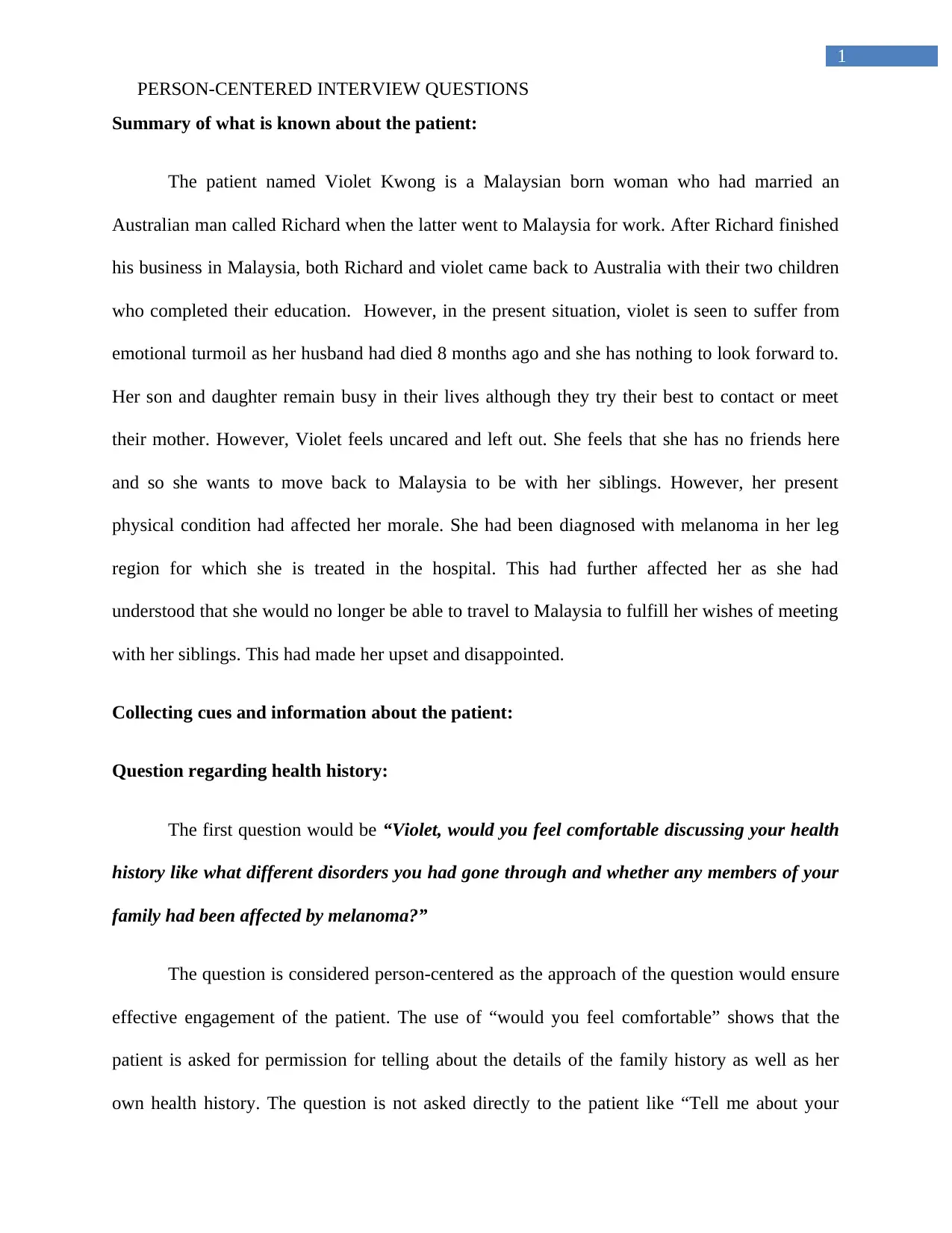
1
PERSON-CENTERED INTERVIEW QUESTIONS
Summary of what is known about the patient:
The patient named Violet Kwong is a Malaysian born woman who had married an
Australian man called Richard when the latter went to Malaysia for work. After Richard finished
his business in Malaysia, both Richard and violet came back to Australia with their two children
who completed their education. However, in the present situation, violet is seen to suffer from
emotional turmoil as her husband had died 8 months ago and she has nothing to look forward to.
Her son and daughter remain busy in their lives although they try their best to contact or meet
their mother. However, Violet feels uncared and left out. She feels that she has no friends here
and so she wants to move back to Malaysia to be with her siblings. However, her present
physical condition had affected her morale. She had been diagnosed with melanoma in her leg
region for which she is treated in the hospital. This had further affected her as she had
understood that she would no longer be able to travel to Malaysia to fulfill her wishes of meeting
with her siblings. This had made her upset and disappointed.
Collecting cues and information about the patient:
Question regarding health history:
The first question would be “Violet, would you feel comfortable discussing your health
history like what different disorders you had gone through and whether any members of your
family had been affected by melanoma?”
The question is considered person-centered as the approach of the question would ensure
effective engagement of the patient. The use of “would you feel comfortable” shows that the
patient is asked for permission for telling about the details of the family history as well as her
own health history. The question is not asked directly to the patient like “Tell me about your
PERSON-CENTERED INTERVIEW QUESTIONS
Summary of what is known about the patient:
The patient named Violet Kwong is a Malaysian born woman who had married an
Australian man called Richard when the latter went to Malaysia for work. After Richard finished
his business in Malaysia, both Richard and violet came back to Australia with their two children
who completed their education. However, in the present situation, violet is seen to suffer from
emotional turmoil as her husband had died 8 months ago and she has nothing to look forward to.
Her son and daughter remain busy in their lives although they try their best to contact or meet
their mother. However, Violet feels uncared and left out. She feels that she has no friends here
and so she wants to move back to Malaysia to be with her siblings. However, her present
physical condition had affected her morale. She had been diagnosed with melanoma in her leg
region for which she is treated in the hospital. This had further affected her as she had
understood that she would no longer be able to travel to Malaysia to fulfill her wishes of meeting
with her siblings. This had made her upset and disappointed.
Collecting cues and information about the patient:
Question regarding health history:
The first question would be “Violet, would you feel comfortable discussing your health
history like what different disorders you had gone through and whether any members of your
family had been affected by melanoma?”
The question is considered person-centered as the approach of the question would ensure
effective engagement of the patient. The use of “would you feel comfortable” shows that the
patient is asked for permission for telling about the details of the family history as well as her
own health history. The question is not asked directly to the patient like “Tell me about your

2
PERSON-CENTERED INTERVIEW QUESTIONS
health history”. This approach would not show her respect and the patient might feel that the
professional is demanding her to reply. Hence, use of the phrase like “would you feel
comfortable” would help in showing respect to the patient making the patient feel that they are
respecting her will of answering and that they are keen in ensuring that the patient does not feel
disrespected (Hashim et al., 2017). This first question would thereby help in developing the first
foundation of trust between Violet and the professional making her feel comfortable. Hence,
person centered approach can be satisfied.
The patient is seen to suffer from melanoma. It is extremely important for the
professional to know that the different risk factors that had made violet subjected to the
development of Melanoma (Bosworth et al., 2017).
Question regarding living situation:
The person centered question would be “how would you describe your living abode….. I
heard that you are living alone now and I feel how difficult it is to live alone … what would
want to mention about your living situation in the current days?”
The question is person-centered. This is because the nurse already has an idea that she is
living alone. However, in such situation, constantly asking her about her living condition might
make her feel depressed and upset again. It might affect her emotions and make her feel bad.
Therefore, it was important for the nursing professional to show empathy and compassion to the
patient making her feel that the professionals are aware of her conditions and feel the same pain
and suffering that she is going through (Yardley et al., 2015). This would enable in developing
rapport with the patient where trust would be strengthened and the patient would communicate
with the professionals smoothly. Studies state that empathy and compassion increases treatment
PERSON-CENTERED INTERVIEW QUESTIONS
health history”. This approach would not show her respect and the patient might feel that the
professional is demanding her to reply. Hence, use of the phrase like “would you feel
comfortable” would help in showing respect to the patient making the patient feel that they are
respecting her will of answering and that they are keen in ensuring that the patient does not feel
disrespected (Hashim et al., 2017). This first question would thereby help in developing the first
foundation of trust between Violet and the professional making her feel comfortable. Hence,
person centered approach can be satisfied.
The patient is seen to suffer from melanoma. It is extremely important for the
professional to know that the different risk factors that had made violet subjected to the
development of Melanoma (Bosworth et al., 2017).
Question regarding living situation:
The person centered question would be “how would you describe your living abode….. I
heard that you are living alone now and I feel how difficult it is to live alone … what would
want to mention about your living situation in the current days?”
The question is person-centered. This is because the nurse already has an idea that she is
living alone. However, in such situation, constantly asking her about her living condition might
make her feel depressed and upset again. It might affect her emotions and make her feel bad.
Therefore, it was important for the nursing professional to show empathy and compassion to the
patient making her feel that the professionals are aware of her conditions and feel the same pain
and suffering that she is going through (Yardley et al., 2015). This would enable in developing
rapport with the patient where trust would be strengthened and the patient would communicate
with the professionals smoothly. Studies state that empathy and compassion increases treatment
⊘ This is a preview!⊘
Do you want full access?
Subscribe today to unlock all pages.

Trusted by 1+ million students worldwide
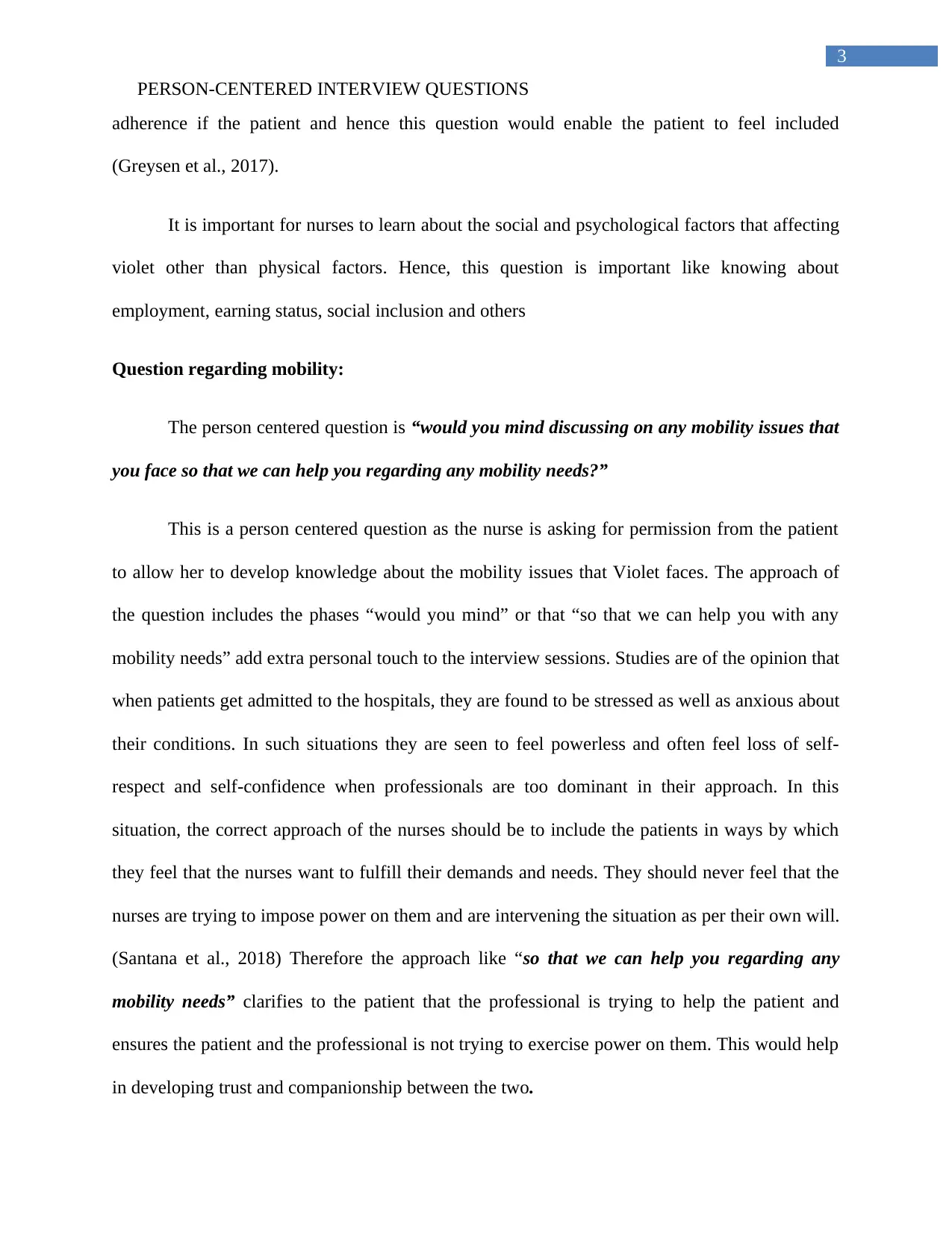
3
PERSON-CENTERED INTERVIEW QUESTIONS
adherence if the patient and hence this question would enable the patient to feel included
(Greysen et al., 2017).
It is important for nurses to learn about the social and psychological factors that affecting
violet other than physical factors. Hence, this question is important like knowing about
employment, earning status, social inclusion and others
Question regarding mobility:
The person centered question is “would you mind discussing on any mobility issues that
you face so that we can help you regarding any mobility needs?”
This is a person centered question as the nurse is asking for permission from the patient
to allow her to develop knowledge about the mobility issues that Violet faces. The approach of
the question includes the phases “would you mind” or that “so that we can help you with any
mobility needs” add extra personal touch to the interview sessions. Studies are of the opinion that
when patients get admitted to the hospitals, they are found to be stressed as well as anxious about
their conditions. In such situations they are seen to feel powerless and often feel loss of self-
respect and self-confidence when professionals are too dominant in their approach. In this
situation, the correct approach of the nurses should be to include the patients in ways by which
they feel that the nurses want to fulfill their demands and needs. They should never feel that the
nurses are trying to impose power on them and are intervening the situation as per their own will.
(Santana et al., 2018) Therefore the approach like “so that we can help you regarding any
mobility needs” clarifies to the patient that the professional is trying to help the patient and
ensures the patient and the professional is not trying to exercise power on them. This would help
in developing trust and companionship between the two.
PERSON-CENTERED INTERVIEW QUESTIONS
adherence if the patient and hence this question would enable the patient to feel included
(Greysen et al., 2017).
It is important for nurses to learn about the social and psychological factors that affecting
violet other than physical factors. Hence, this question is important like knowing about
employment, earning status, social inclusion and others
Question regarding mobility:
The person centered question is “would you mind discussing on any mobility issues that
you face so that we can help you regarding any mobility needs?”
This is a person centered question as the nurse is asking for permission from the patient
to allow her to develop knowledge about the mobility issues that Violet faces. The approach of
the question includes the phases “would you mind” or that “so that we can help you with any
mobility needs” add extra personal touch to the interview sessions. Studies are of the opinion that
when patients get admitted to the hospitals, they are found to be stressed as well as anxious about
their conditions. In such situations they are seen to feel powerless and often feel loss of self-
respect and self-confidence when professionals are too dominant in their approach. In this
situation, the correct approach of the nurses should be to include the patients in ways by which
they feel that the nurses want to fulfill their demands and needs. They should never feel that the
nurses are trying to impose power on them and are intervening the situation as per their own will.
(Santana et al., 2018) Therefore the approach like “so that we can help you regarding any
mobility needs” clarifies to the patient that the professional is trying to help the patient and
ensures the patient and the professional is not trying to exercise power on them. This would help
in developing trust and companionship between the two.
Paraphrase This Document
Need a fresh take? Get an instant paraphrase of this document with our AI Paraphraser
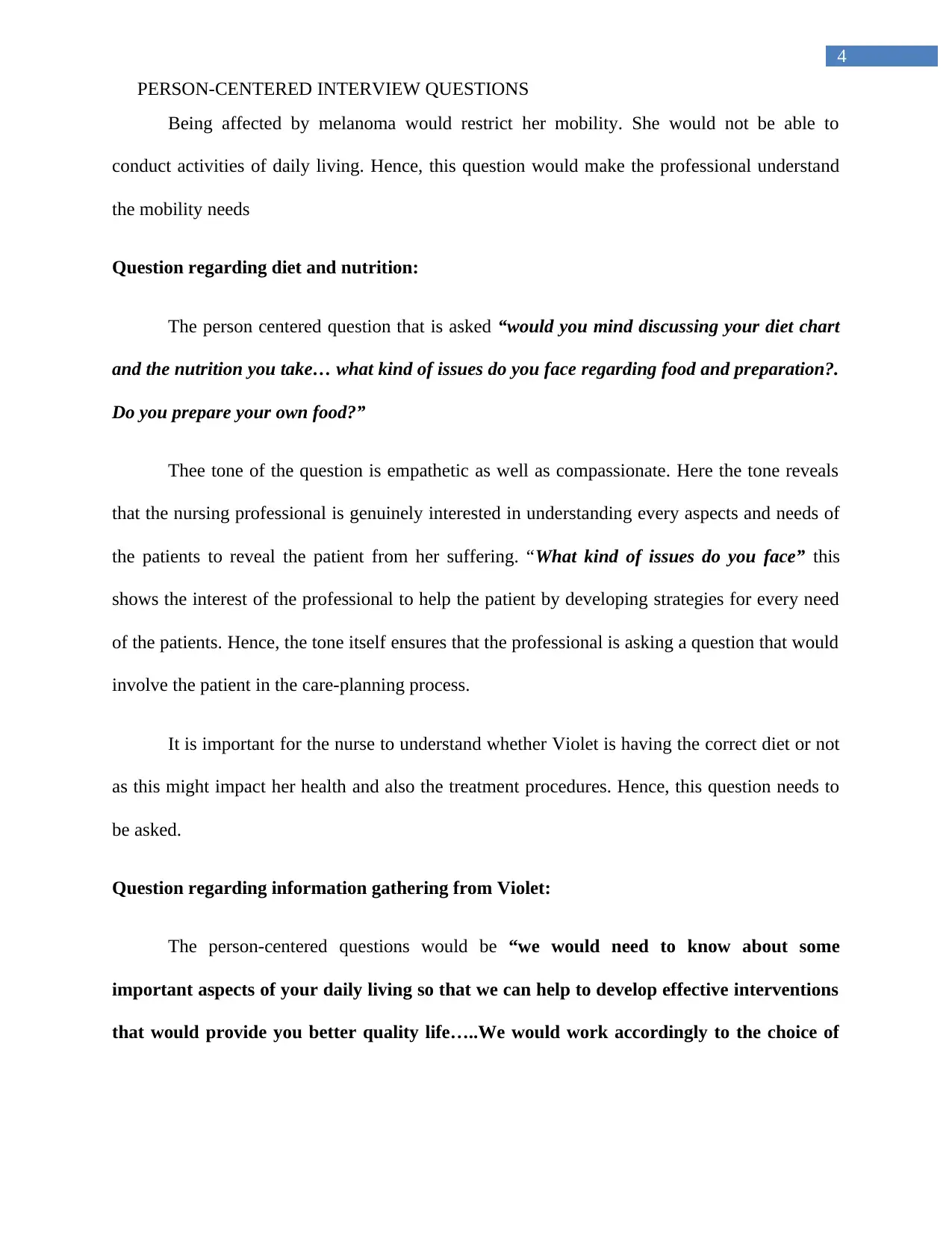
4
PERSON-CENTERED INTERVIEW QUESTIONS
Being affected by melanoma would restrict her mobility. She would not be able to
conduct activities of daily living. Hence, this question would make the professional understand
the mobility needs
Question regarding diet and nutrition:
The person centered question that is asked “would you mind discussing your diet chart
and the nutrition you take… what kind of issues do you face regarding food and preparation?.
Do you prepare your own food?”
Thee tone of the question is empathetic as well as compassionate. Here the tone reveals
that the nursing professional is genuinely interested in understanding every aspects and needs of
the patients to reveal the patient from her suffering. “What kind of issues do you face” this
shows the interest of the professional to help the patient by developing strategies for every need
of the patients. Hence, the tone itself ensures that the professional is asking a question that would
involve the patient in the care-planning process.
It is important for the nurse to understand whether Violet is having the correct diet or not
as this might impact her health and also the treatment procedures. Hence, this question needs to
be asked.
Question regarding information gathering from Violet:
The person-centered questions would be “we would need to know about some
important aspects of your daily living so that we can help to develop effective interventions
that would provide you better quality life…..We would work accordingly to the choice of
PERSON-CENTERED INTERVIEW QUESTIONS
Being affected by melanoma would restrict her mobility. She would not be able to
conduct activities of daily living. Hence, this question would make the professional understand
the mobility needs
Question regarding diet and nutrition:
The person centered question that is asked “would you mind discussing your diet chart
and the nutrition you take… what kind of issues do you face regarding food and preparation?.
Do you prepare your own food?”
Thee tone of the question is empathetic as well as compassionate. Here the tone reveals
that the nursing professional is genuinely interested in understanding every aspects and needs of
the patients to reveal the patient from her suffering. “What kind of issues do you face” this
shows the interest of the professional to help the patient by developing strategies for every need
of the patients. Hence, the tone itself ensures that the professional is asking a question that would
involve the patient in the care-planning process.
It is important for the nurse to understand whether Violet is having the correct diet or not
as this might impact her health and also the treatment procedures. Hence, this question needs to
be asked.
Question regarding information gathering from Violet:
The person-centered questions would be “we would need to know about some
important aspects of your daily living so that we can help to develop effective interventions
that would provide you better quality life…..We would work accordingly to the choice of

5
PERSON-CENTERED INTERVIEW QUESTIONS
interventions that you would be choosing by yourself and so we would need your
cooperation?”
This is a person centered approach. One of the most important aspects of person centered
care is to include the patient in her own care and to work according to the care plans that have
been decided by the patients for themselves. The question is set with the tone where the nurse is
respecting the patient and at the same time making her know that she would need to provide
important details about herself. Hence, asking this question would make her feel respected and
more involved in her own care.
Studies opine that nurses need to establish a therapeutic relationship with the patient that
would be based on trust and mutual respect. This can be achieved by a person centered approach
where patients feel included in the care (Santana et al., 2018). Nurses need to include patients in
decision making as well as care planning. Hence, revealing of much important information is
important by the patient to understand the needs of the patient. Hence, this question is asked to
gain information from patient and thereby jot them down to develop best interventions and make
her feel included in her care.
Summary of how the questions would help:
First, Melanoma might occur because of risk factors like excessive sun exposure, indoor
tanning, moles, fair skin, family history, previous skin cancer, age and also weakened immune
system (Mattia et al., 2018). Therefore, knowing about the health history of Violet would help
the professional in knowing that specific causes for which Violet had been more vulnerable to
the disorder. Moreover, knowing in details about the previous health history and the medical
conditions of Violet would enable the healthcare team in developing care plans that would help
PERSON-CENTERED INTERVIEW QUESTIONS
interventions that you would be choosing by yourself and so we would need your
cooperation?”
This is a person centered approach. One of the most important aspects of person centered
care is to include the patient in her own care and to work according to the care plans that have
been decided by the patients for themselves. The question is set with the tone where the nurse is
respecting the patient and at the same time making her know that she would need to provide
important details about herself. Hence, asking this question would make her feel respected and
more involved in her own care.
Studies opine that nurses need to establish a therapeutic relationship with the patient that
would be based on trust and mutual respect. This can be achieved by a person centered approach
where patients feel included in the care (Santana et al., 2018). Nurses need to include patients in
decision making as well as care planning. Hence, revealing of much important information is
important by the patient to understand the needs of the patient. Hence, this question is asked to
gain information from patient and thereby jot them down to develop best interventions and make
her feel included in her care.
Summary of how the questions would help:
First, Melanoma might occur because of risk factors like excessive sun exposure, indoor
tanning, moles, fair skin, family history, previous skin cancer, age and also weakened immune
system (Mattia et al., 2018). Therefore, knowing about the health history of Violet would help
the professional in knowing that specific causes for which Violet had been more vulnerable to
the disorder. Moreover, knowing in details about the previous health history and the medical
conditions of Violet would enable the healthcare team in developing care plans that would help
⊘ This is a preview!⊘
Do you want full access?
Subscribe today to unlock all pages.

Trusted by 1+ million students worldwide
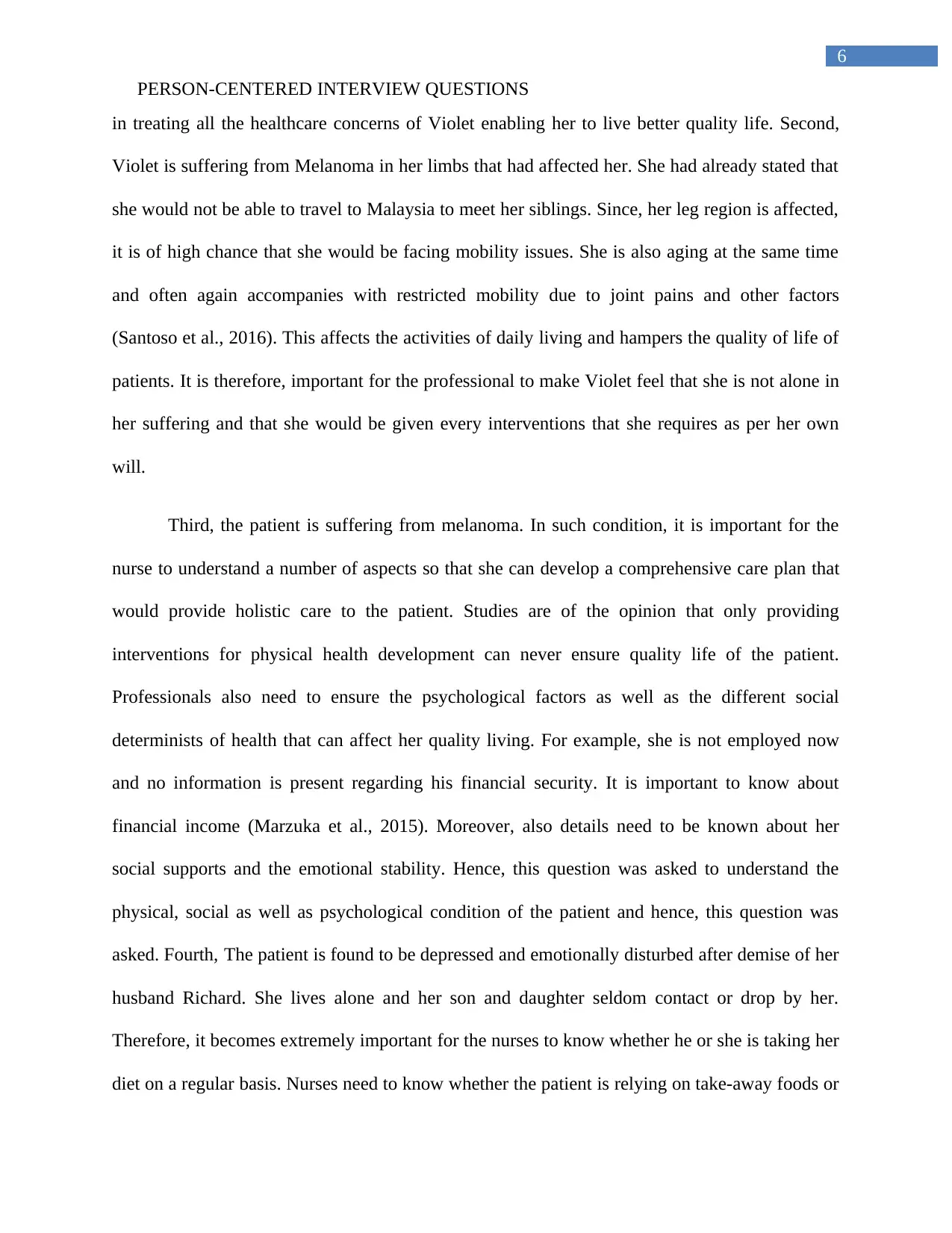
6
PERSON-CENTERED INTERVIEW QUESTIONS
in treating all the healthcare concerns of Violet enabling her to live better quality life. Second,
Violet is suffering from Melanoma in her limbs that had affected her. She had already stated that
she would not be able to travel to Malaysia to meet her siblings. Since, her leg region is affected,
it is of high chance that she would be facing mobility issues. She is also aging at the same time
and often again accompanies with restricted mobility due to joint pains and other factors
(Santoso et al., 2016). This affects the activities of daily living and hampers the quality of life of
patients. It is therefore, important for the professional to make Violet feel that she is not alone in
her suffering and that she would be given every interventions that she requires as per her own
will.
Third, the patient is suffering from melanoma. In such condition, it is important for the
nurse to understand a number of aspects so that she can develop a comprehensive care plan that
would provide holistic care to the patient. Studies are of the opinion that only providing
interventions for physical health development can never ensure quality life of the patient.
Professionals also need to ensure the psychological factors as well as the different social
determinists of health that can affect her quality living. For example, she is not employed now
and no information is present regarding his financial security. It is important to know about
financial income (Marzuka et al., 2015). Moreover, also details need to be known about her
social supports and the emotional stability. Hence, this question was asked to understand the
physical, social as well as psychological condition of the patient and hence, this question was
asked. Fourth, The patient is found to be depressed and emotionally disturbed after demise of her
husband Richard. She lives alone and her son and daughter seldom contact or drop by her.
Therefore, it becomes extremely important for the nurses to know whether he or she is taking her
diet on a regular basis. Nurses need to know whether the patient is relying on take-away foods or
PERSON-CENTERED INTERVIEW QUESTIONS
in treating all the healthcare concerns of Violet enabling her to live better quality life. Second,
Violet is suffering from Melanoma in her limbs that had affected her. She had already stated that
she would not be able to travel to Malaysia to meet her siblings. Since, her leg region is affected,
it is of high chance that she would be facing mobility issues. She is also aging at the same time
and often again accompanies with restricted mobility due to joint pains and other factors
(Santoso et al., 2016). This affects the activities of daily living and hampers the quality of life of
patients. It is therefore, important for the professional to make Violet feel that she is not alone in
her suffering and that she would be given every interventions that she requires as per her own
will.
Third, the patient is suffering from melanoma. In such condition, it is important for the
nurse to understand a number of aspects so that she can develop a comprehensive care plan that
would provide holistic care to the patient. Studies are of the opinion that only providing
interventions for physical health development can never ensure quality life of the patient.
Professionals also need to ensure the psychological factors as well as the different social
determinists of health that can affect her quality living. For example, she is not employed now
and no information is present regarding his financial security. It is important to know about
financial income (Marzuka et al., 2015). Moreover, also details need to be known about her
social supports and the emotional stability. Hence, this question was asked to understand the
physical, social as well as psychological condition of the patient and hence, this question was
asked. Fourth, The patient is found to be depressed and emotionally disturbed after demise of her
husband Richard. She lives alone and her son and daughter seldom contact or drop by her.
Therefore, it becomes extremely important for the nurses to know whether he or she is taking her
diet on a regular basis. Nurses need to know whether the patient is relying on take-away foods or
Paraphrase This Document
Need a fresh take? Get an instant paraphrase of this document with our AI Paraphraser

7
PERSON-CENTERED INTERVIEW QUESTIONS
on nutritious foods. Studies are of the opinion that melanoma affected needs to have strict diet so
that they do not lose of gain weight but have correct energy requirement in their body to tackle
the treatments (Morrison et al., 2017). Hence, knowing about diets of the patients is extremely
important. It is also important to understand the health literacy of the patient about the
importance of taking proper diet.
Therefore, asking these questions was important. In this ways, the questions could have
helped in developing care plan that helped in providing safe and quality care to the patient.
Processing of the information:
The blood pressure of the patient is found to be 100/60. This is the abnormal blood
pressure as the normal blood pressure needs to be 120/80. The heart rate of the patient needs to
60-100 whereas that of Violet is 115. These are the two inappropriate data that needs to be
managed in Violet. Studies are of the opinion that cancer patients receiving chemotherapy often
develops anemia which results in rapid heart rate (Pasquali et al., 2018). Again, on the other
hand, anemia occurrence results in reducing the blood pressure of individuals. Hence, the patient
might be having such abnormal data. The nurses need to manage the symptoms to ensure safety
of the patient.
Reflection:
While communicating with the patient named violet, I followed the sub-standard number
2.2 diligently. It talks about the importance of communicating effectively and at the same time
being respectful of the dignity, culture, values as well as beliefs. I tried to initiate therapeutic
communication with him that included an empathetic and compassionate approach to her. I tried
to establish an emotional bond with her in order to make her feel comfortable about much
PERSON-CENTERED INTERVIEW QUESTIONS
on nutritious foods. Studies are of the opinion that melanoma affected needs to have strict diet so
that they do not lose of gain weight but have correct energy requirement in their body to tackle
the treatments (Morrison et al., 2017). Hence, knowing about diets of the patients is extremely
important. It is also important to understand the health literacy of the patient about the
importance of taking proper diet.
Therefore, asking these questions was important. In this ways, the questions could have
helped in developing care plan that helped in providing safe and quality care to the patient.
Processing of the information:
The blood pressure of the patient is found to be 100/60. This is the abnormal blood
pressure as the normal blood pressure needs to be 120/80. The heart rate of the patient needs to
60-100 whereas that of Violet is 115. These are the two inappropriate data that needs to be
managed in Violet. Studies are of the opinion that cancer patients receiving chemotherapy often
develops anemia which results in rapid heart rate (Pasquali et al., 2018). Again, on the other
hand, anemia occurrence results in reducing the blood pressure of individuals. Hence, the patient
might be having such abnormal data. The nurses need to manage the symptoms to ensure safety
of the patient.
Reflection:
While communicating with the patient named violet, I followed the sub-standard number
2.2 diligently. It talks about the importance of communicating effectively and at the same time
being respectful of the dignity, culture, values as well as beliefs. I tried to initiate therapeutic
communication with him that included an empathetic and compassionate approach to her. I tried
to establish an emotional bond with her in order to make her feel comfortable about much
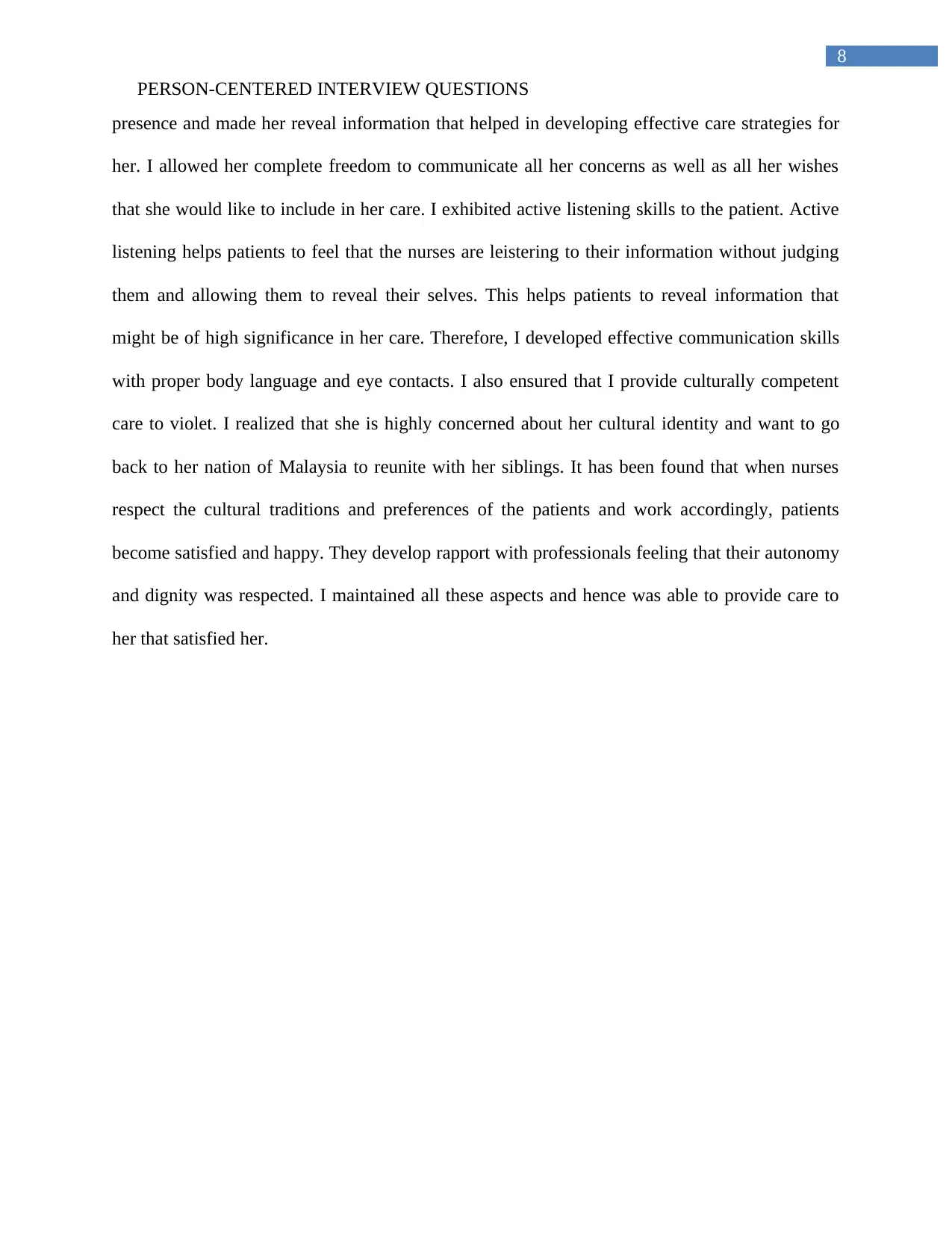
8
PERSON-CENTERED INTERVIEW QUESTIONS
presence and made her reveal information that helped in developing effective care strategies for
her. I allowed her complete freedom to communicate all her concerns as well as all her wishes
that she would like to include in her care. I exhibited active listening skills to the patient. Active
listening helps patients to feel that the nurses are leistering to their information without judging
them and allowing them to reveal their selves. This helps patients to reveal information that
might be of high significance in her care. Therefore, I developed effective communication skills
with proper body language and eye contacts. I also ensured that I provide culturally competent
care to violet. I realized that she is highly concerned about her cultural identity and want to go
back to her nation of Malaysia to reunite with her siblings. It has been found that when nurses
respect the cultural traditions and preferences of the patients and work accordingly, patients
become satisfied and happy. They develop rapport with professionals feeling that their autonomy
and dignity was respected. I maintained all these aspects and hence was able to provide care to
her that satisfied her.
PERSON-CENTERED INTERVIEW QUESTIONS
presence and made her reveal information that helped in developing effective care strategies for
her. I allowed her complete freedom to communicate all her concerns as well as all her wishes
that she would like to include in her care. I exhibited active listening skills to the patient. Active
listening helps patients to feel that the nurses are leistering to their information without judging
them and allowing them to reveal their selves. This helps patients to reveal information that
might be of high significance in her care. Therefore, I developed effective communication skills
with proper body language and eye contacts. I also ensured that I provide culturally competent
care to violet. I realized that she is highly concerned about her cultural identity and want to go
back to her nation of Malaysia to reunite with her siblings. It has been found that when nurses
respect the cultural traditions and preferences of the patients and work accordingly, patients
become satisfied and happy. They develop rapport with professionals feeling that their autonomy
and dignity was respected. I maintained all these aspects and hence was able to provide care to
her that satisfied her.
⊘ This is a preview!⊘
Do you want full access?
Subscribe today to unlock all pages.

Trusted by 1+ million students worldwide
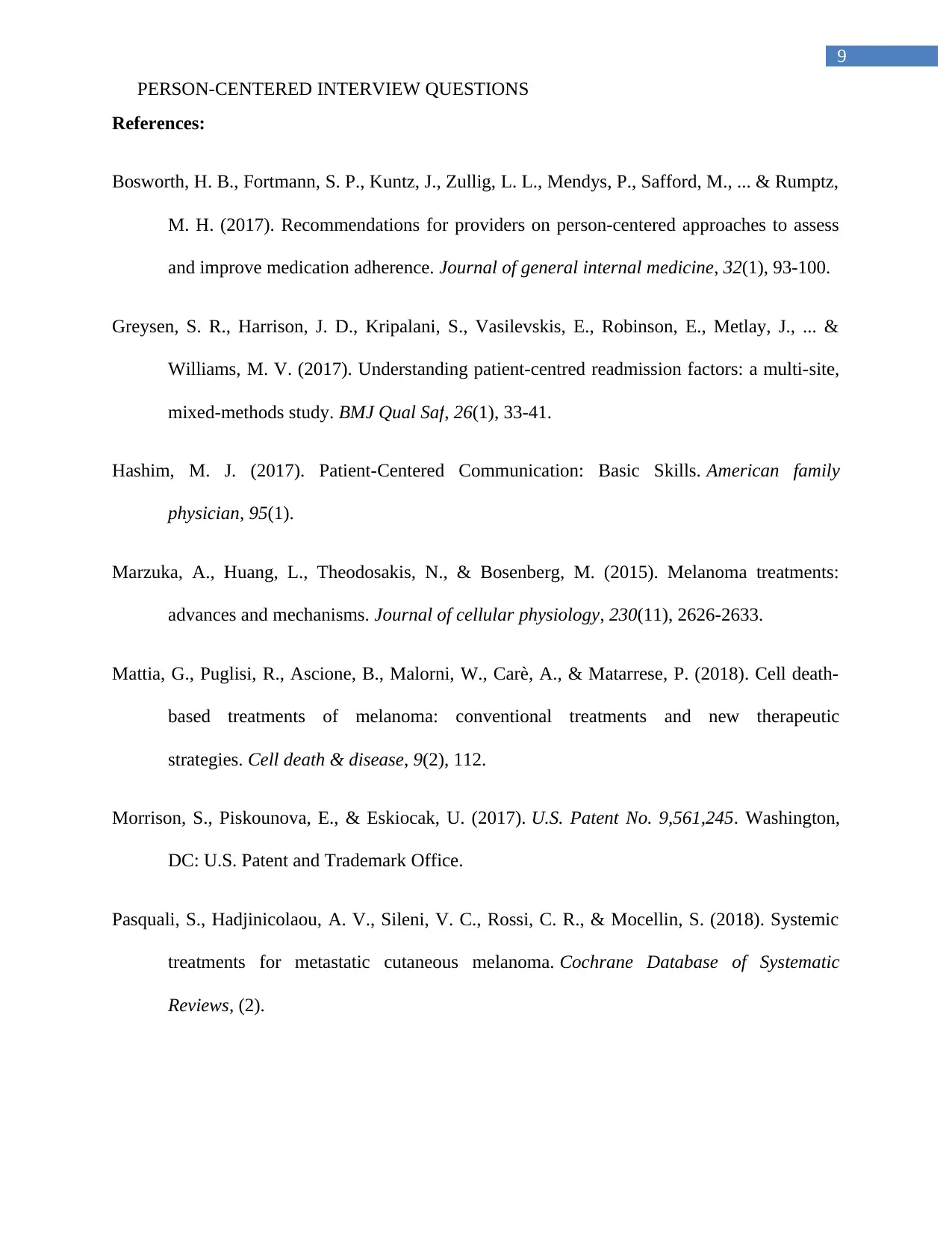
9
PERSON-CENTERED INTERVIEW QUESTIONS
References:
Bosworth, H. B., Fortmann, S. P., Kuntz, J., Zullig, L. L., Mendys, P., Safford, M., ... & Rumptz,
M. H. (2017). Recommendations for providers on person-centered approaches to assess
and improve medication adherence. Journal of general internal medicine, 32(1), 93-100.
Greysen, S. R., Harrison, J. D., Kripalani, S., Vasilevskis, E., Robinson, E., Metlay, J., ... &
Williams, M. V. (2017). Understanding patient-centred readmission factors: a multi-site,
mixed-methods study. BMJ Qual Saf, 26(1), 33-41.
Hashim, M. J. (2017). Patient-Centered Communication: Basic Skills. American family
physician, 95(1).
Marzuka, A., Huang, L., Theodosakis, N., & Bosenberg, M. (2015). Melanoma treatments:
advances and mechanisms. Journal of cellular physiology, 230(11), 2626-2633.
Mattia, G., Puglisi, R., Ascione, B., Malorni, W., Carè, A., & Matarrese, P. (2018). Cell death-
based treatments of melanoma: conventional treatments and new therapeutic
strategies. Cell death & disease, 9(2), 112.
Morrison, S., Piskounova, E., & Eskiocak, U. (2017). U.S. Patent No. 9,561,245. Washington,
DC: U.S. Patent and Trademark Office.
Pasquali, S., Hadjinicolaou, A. V., Sileni, V. C., Rossi, C. R., & Mocellin, S. (2018). Systemic
treatments for metastatic cutaneous melanoma. Cochrane Database of Systematic
Reviews, (2).
PERSON-CENTERED INTERVIEW QUESTIONS
References:
Bosworth, H. B., Fortmann, S. P., Kuntz, J., Zullig, L. L., Mendys, P., Safford, M., ... & Rumptz,
M. H. (2017). Recommendations for providers on person-centered approaches to assess
and improve medication adherence. Journal of general internal medicine, 32(1), 93-100.
Greysen, S. R., Harrison, J. D., Kripalani, S., Vasilevskis, E., Robinson, E., Metlay, J., ... &
Williams, M. V. (2017). Understanding patient-centred readmission factors: a multi-site,
mixed-methods study. BMJ Qual Saf, 26(1), 33-41.
Hashim, M. J. (2017). Patient-Centered Communication: Basic Skills. American family
physician, 95(1).
Marzuka, A., Huang, L., Theodosakis, N., & Bosenberg, M. (2015). Melanoma treatments:
advances and mechanisms. Journal of cellular physiology, 230(11), 2626-2633.
Mattia, G., Puglisi, R., Ascione, B., Malorni, W., Carè, A., & Matarrese, P. (2018). Cell death-
based treatments of melanoma: conventional treatments and new therapeutic
strategies. Cell death & disease, 9(2), 112.
Morrison, S., Piskounova, E., & Eskiocak, U. (2017). U.S. Patent No. 9,561,245. Washington,
DC: U.S. Patent and Trademark Office.
Pasquali, S., Hadjinicolaou, A. V., Sileni, V. C., Rossi, C. R., & Mocellin, S. (2018). Systemic
treatments for metastatic cutaneous melanoma. Cochrane Database of Systematic
Reviews, (2).
Paraphrase This Document
Need a fresh take? Get an instant paraphrase of this document with our AI Paraphraser
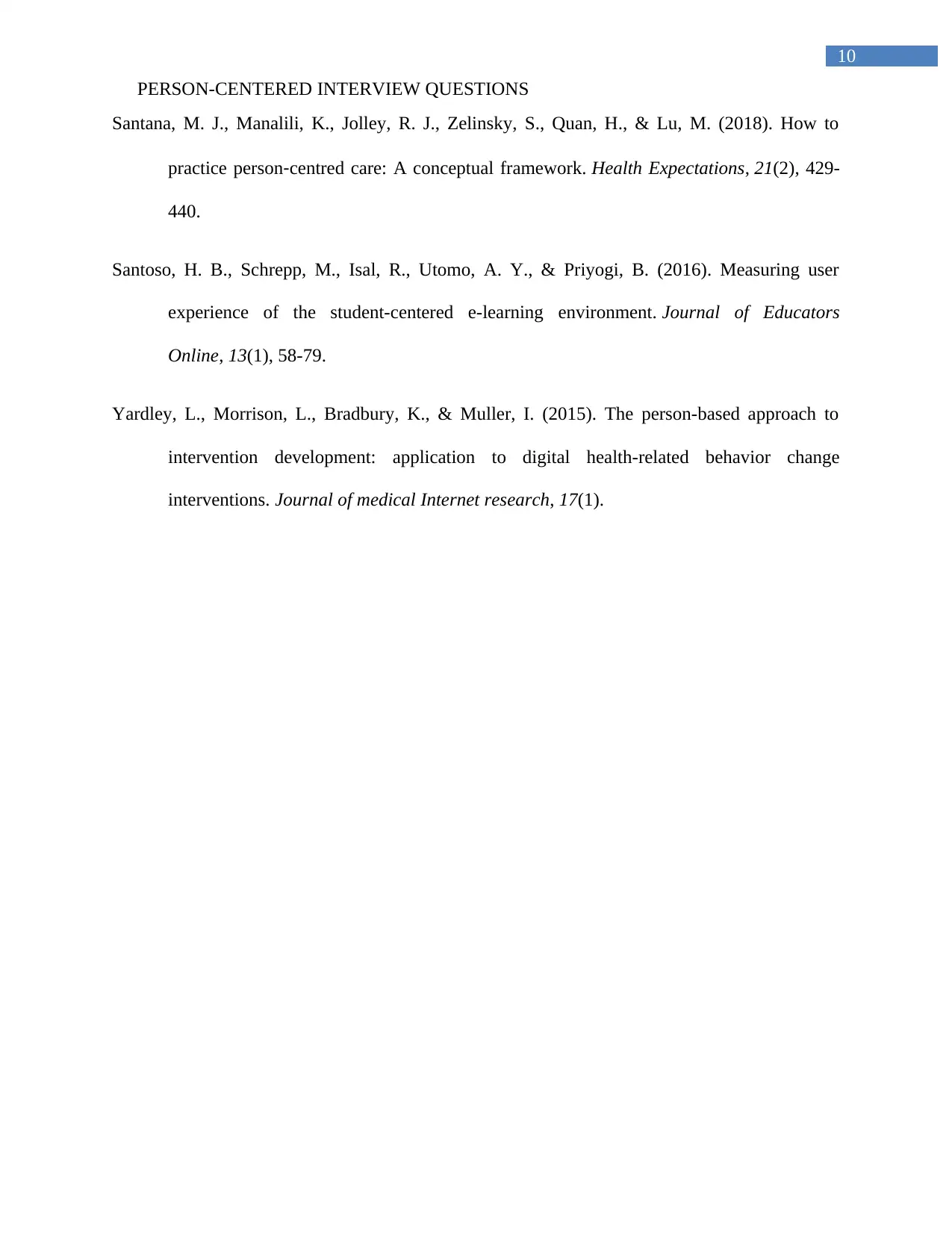
10
PERSON-CENTERED INTERVIEW QUESTIONS
Santana, M. J., Manalili, K., Jolley, R. J., Zelinsky, S., Quan, H., & Lu, M. (2018). How to
practice person‐centred care: A conceptual framework. Health Expectations, 21(2), 429-
440.
Santoso, H. B., Schrepp, M., Isal, R., Utomo, A. Y., & Priyogi, B. (2016). Measuring user
experience of the student-centered e-learning environment. Journal of Educators
Online, 13(1), 58-79.
Yardley, L., Morrison, L., Bradbury, K., & Muller, I. (2015). The person-based approach to
intervention development: application to digital health-related behavior change
interventions. Journal of medical Internet research, 17(1).
PERSON-CENTERED INTERVIEW QUESTIONS
Santana, M. J., Manalili, K., Jolley, R. J., Zelinsky, S., Quan, H., & Lu, M. (2018). How to
practice person‐centred care: A conceptual framework. Health Expectations, 21(2), 429-
440.
Santoso, H. B., Schrepp, M., Isal, R., Utomo, A. Y., & Priyogi, B. (2016). Measuring user
experience of the student-centered e-learning environment. Journal of Educators
Online, 13(1), 58-79.
Yardley, L., Morrison, L., Bradbury, K., & Muller, I. (2015). The person-based approach to
intervention development: application to digital health-related behavior change
interventions. Journal of medical Internet research, 17(1).
1 out of 11
Related Documents
Your All-in-One AI-Powered Toolkit for Academic Success.
+13062052269
info@desklib.com
Available 24*7 on WhatsApp / Email
![[object Object]](/_next/static/media/star-bottom.7253800d.svg)
Unlock your academic potential
Copyright © 2020–2025 A2Z Services. All Rights Reserved. Developed and managed by ZUCOL.





